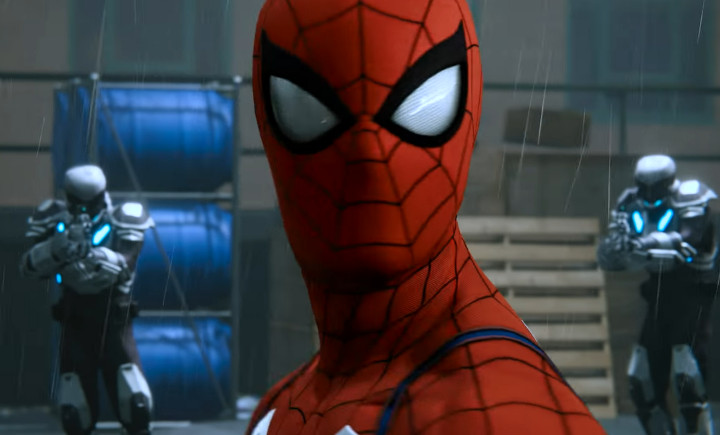
The Half-Glass Gaming crew was having a chat about Spider-Man the other day, which left me wondering just how many Spider-Man video games there are. The answer is a lot.
So I made a complete list of every Spider-Man game ever made, starting with the 1982 Atari 2600 game. You can read the first half of the list over at our sister site Retrovolve, where we cover the 1980s and 1990s. Here, we’re picking up at the turn of the century, after Sony had acquired the film rights to Spider-Man.
And, while I acknowledge Spider-Man’s inclusion in games like Marvel vs. Capcom: Infinite and Marvel Ultimate Alliance 3: The Black Order, I’m going to stick with pure Spider-Man games here — this list is long enough as it is.
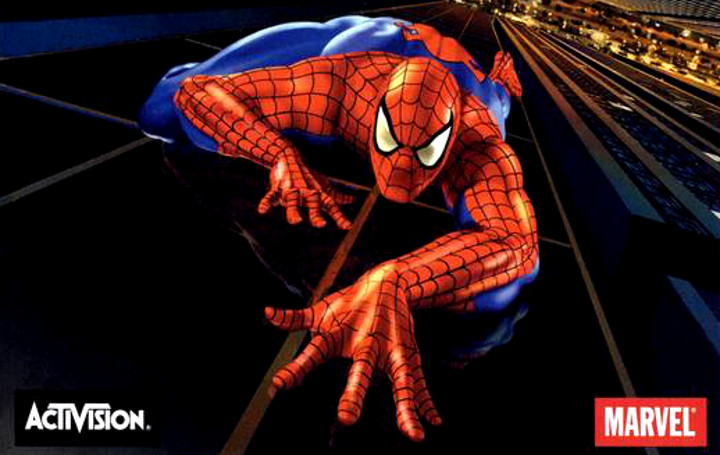
Spider-Man (2000) – The first game to release after Sony’s acquisition would be a game not yet based on the movies and aptly titled Spider-Man. It was released for Sony PlayStation, Nintendo 64, and Game Boy Color (with Dreamcast and Microsoft Windows versions coming out the following year). This one had various developers handling different versions: Neversoft for PlayStation, Vicarious Visions for the Game Boy Color, Edge of Reality for the N64, Treyarch for the Dreamcast, and LTI Gray Matter for the PC. It also featured music composed by the legendary Tommy Tallarico.
This game was notable as the first of many Spider-Man games that would be published by Activision, a partnership that would continue for the next 15 years. This would also lead to Spider-Man’s appearance as a secret character in 2000’s Tony Hawk’s Pro Skater 2, which was also developed by Neversoft and published by Activision.
Spider-Man 2: The Sinister Six (2001) – Developed by Torus (and published by Activision), Spider-Man 2: The Sinister Six for Game Boy Color (released in May of 2001) is not a sequel to Spider-Man: Return of the Sinister Six (which we covered in the first half of this list). Instead, it’s a direct sequel to the 2000 game (following the events of the Game Boy Color version).
Spider-Man 2: Enter Electro (2001) – Another sequel to 2000’s Spider-Man, this one was developed by Vicarious Visions for the Sony PlayStation and released in October. It originally featured a scene atop the World Trader Center, but due to the events of September 11 of that year, the scene was changed to be just some generic building. This would also be the first PlayStation-exclusive Spider-Man video game.
Spider-Man: Mysterio’s Menace (2001) – Also developed by Vicarious Visions, Spider-Man: Mysterio’s Menace is a sequel to Enter Electro. However, with a September 19 release date, it beat Enter Electro to market (likely an unintended result of Enter Electro‘s last-minute revisions in the wake of the September 11 terrorist attacks).

In 2002, Sony’s acquisition would bear fruit with the release of the first of their Spider-Man films (starring Tobey Maguire). And this is where we start to see the movie tie-ins hitting store shelves.
Spider-Man (2002) – Alongside the film came yet another game simply titled Spider-Man (this is the fourth game with this title, following the 1982, 1995, and 2000 releases). Curious enough, this wasn’t exclusive to Sony’s platform (remember, Sony didn’t get exclusive rights to video-game portrayals of Spider-Man; they just got the film rights). Treyarch would handle development for the main version, which came to PS2, Xbox, and Nintendo GameCube. LTI Gray Matter helped out with the PC port, and Digital Eclipse would handle development for the Game Boy Advance version.
Spider-Man 2 (2004) – Based on the second of the films to star Tobey Maguire, Spider-Man 2 was widely considered the one of the best Spider-Man games of all time — if not the best before it was dethroned by 2018’s Marvel’s Spider-Man. This is the game that introduced Spider-Man to the open-world setting, allowing players to freely web-sling through a digitally realized New York City.
Spider-Man 2 was released for basically every platform at the time, with versions on the PS2, GameCube, Game Boy Advance, Microsoft Windows, Xbox, N-Gage, Mac OS X, Nintendo DS, and PlayStation Portable. Treyarch handled most of the development, with Digital Eclipse (GBA, N-Gage), Foundation 9 Entertainment (PC), Aspyr (Mac), and Vicarious Visions (DS, PSP) handling ports.
Spider-Man & Friends (2005) – In 2005, Spider-Man would appear in the edutainment game, Spider-Man & Friends for PC. The game was designed for young children and featured learning activities about math, language, and color and shape recognition. It was developed by Activision Value. Activision Value would also make Spider-Man Print Studio, but I don’t think I would categorize that as a video game, so let’s just leave that one alone for now.
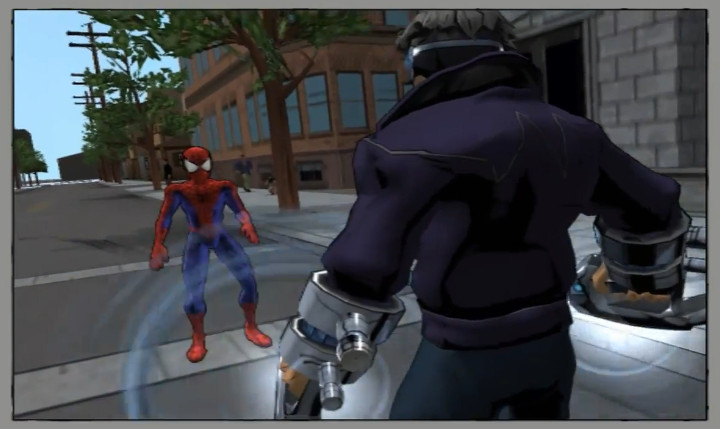
Ultimate Spider-Man (2005) – Ultimate Spider-Man would retread the much-lauded gameplay mechanics of Spider-Man 2, only with a cel-shaded art style and a new take on the tried-and-true Peter Parker origin story. As part of Marvel’s Ultimate universe, the game follows the storyline of the Ultimate Spider-Man comics by Brian Michael Bendis and Mark Bagley. This is arguably my second-favorite Spider-Man game — only behind 2018’s Marvel’s Spider-Man.
Treyarch would handle development for the PS2, Xbox, and GameCube, with Beenox (which had been acquired by Activision in 2005) working on the PC port. Vicarious Visions took on the handheld ports for Nintendo DS and Game Boy Advance.
Spider-Man: Battle for New York (2006) – Ultimate Spider-Man would be followed up one year later by Spider-Man: Battle for New York, solely a handheld installment for the Nintendo DS and Game Boy Advance. Developed by Torus Games, this one pits Spider-Man against the goblin army in a reimagining of Spidey’s first encounter with the Green Goblin.
Spider-Man 3 (2007) – The lukewarm Spider-Man 3 would release in 2007, itself a movie tie-in to the also-lukewarm Spider-Man 3 film (which would be the end of Tobey Maguire as Spider-Man and the final film in the Sam Raimi trilogy). The game would land on every console under the sun at the time: PS2, PS3, Xbox 360, Wii, PlayStation Portable, Windows, Game Boy Advance, and Nintendo DS. Treyarch handled the “next-gen” (PS3 and Xbox 360) versions, Vicarious Visions handled the aging systems, and Beenox was once again responsible for the PC port. Activision was still acting as the sole publisher of Spider-Man games at the time.
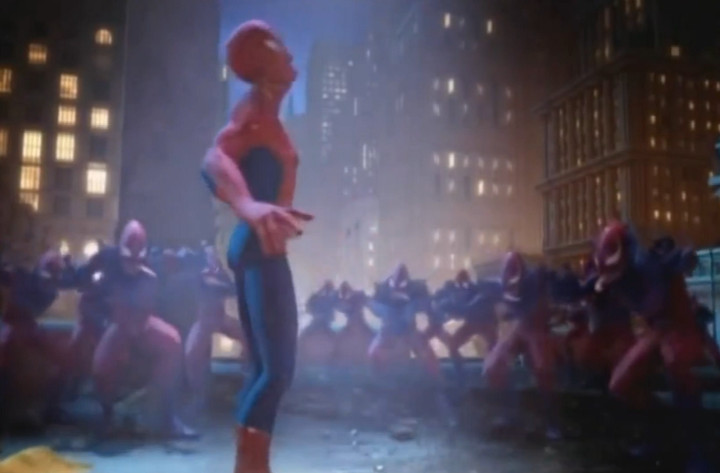
Spider-Man: Friend or Foe (2007) – Later that year, Spider-Man 3 was followed by the more cartoony action brawler, Spider-Man: Friend or Foe. It released for PS2 (though oddly not PS3), Xbox 360, Wii, PlayStation Portable, Nintendo DS, and PC. Next Level Games handled the major consoles, with Artificial Mind & Movement taking on handheld duties and Beenox on PC yet again.
Spider-Man: Web of Shadows (2008) – Spider-Man: Web of Shadows was a bloated yet still excellent return to the open world formula. Shaba Games and Treyarch handled this one, which released on PS3, Wii, Xbox 360, and PC. Griptonite Games developed the Nintendo DS version, which was actually a completely different game — this one was a classic-style side-scrolling beat-’em-up.
Spider-Man: Web of Shadows – Amazing Allies Edition (2008) – An alternate version of Web of Shadows was created by Amaze Entertainment for PS2 and PSP, this one being a 2.5D side-scrolling beat-’em-up (similar to the DS version).
Spider-Man: Toxic City (2009) – The mobile game Spider-Man: Toxic City would be the only Spider-Man game of 2009. It was developed by Gameloft and published directly by Marvel Comics, as Activision was publishing Spider-Man games for traditional platforms but not mobile.
Over the next three years, development started to slow down. Fans of the web crawler were starting to get burned out on the open-world formula popularized by Spider-Man 2, especially since the formula was not really being improved upon in any meaningful way from release to release (the exception being Web of Shadows, which received decent reviews). Perhaps Activision was partially to blame, as many fans were complaining about Activision’s rise-and-repeat methodology for releasing video games (similar complaints were being made about the Tony Hawk’s Pro Skater series at the time).

Spider-Man: Shattered Dimensions (2010) – Perhaps as an answer to the criticisms mentioned above, Spider-Man: Shattered Dimensions would be a more linear experience, shying away from the open-world setting. It focused on four alternate versions of Spider-Man, each with a unique tone and playstyle. This would go on to inspire the Spider-Verse comic series, which would in turn inspire the animated film Spider-Man: Into the Spider-Verse. Beenox had taken the mantle from Treyarch (who was fully involved with Call of Duty: Black Ops by that point), and Shattered Dimensions released for PS3, Wii, Xbox 360, and PC. Griptonite Games also handled a Nintendo DS version, which was another side-scrolling beat-’em-up.
Ultimate Spider-Man: Total Mayhem (2010) – Ultimate Spider: Man: Total Mayhem was an action-adventure game for mobile devices (iOS and Android). It was both developed and published by Gameloft.
Spider-Man: Edge of Time (2011) – Spider-Man: Edge of Time would continue the theme of alternate realities, but unlike Shattered Dimensions, Edge of Time would only focus on the original Spider-Man and Spider-Man 2099. The hook is that each Spider-Man would solve puzzles in their own universe that would aid in the traversal of the other’s universe.
Despite bringing in comic-book heavyweight Peter David to work on the script, Edge of Time was met with mixed reviews. Some fans appreciated the more focused story, while others lamented the demise of the more robust open-world web-slinging last seen in Web of Shadows. Edge of Time was released for PS3, Xbox 360, and Wii under Beenox, while Other Ocean Interactive developed the handheld version for Nintendo DS and 3DS.
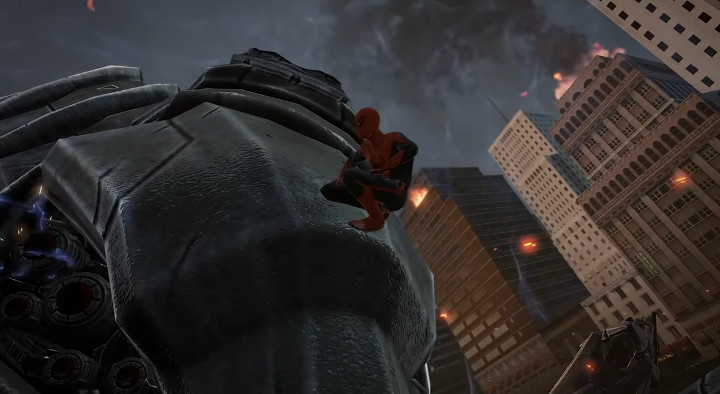
The Amazing Spider-Man (2012) – 2012 should have been a big year for Spider-Man video games, seeing the release of The Amazing Spider-Man, which was based on the film of the same name. Sony was looking to reboot the film franchise after the abysmal Spider-Man 3, replacing Tobey Maguire with Andrew Garfield. The Amazing Spider-Man (the game) would return to the open-world gameplay that the previous film trilogy helped to establish, though it would pale in comparison to 2004’s Spider-Man 2, which was quite groundbreaking back in its day.
Unfortunately, both the newly rebooted film series and the accompanying game series would sort of fizzle. The Amazing Spider-Man (the game) wasn’t terrible; it just wasn’t anything special. Beenox would handle development of the main version for PS3, Xbox 360, Wii, and PC, with Other Ocean Interactive working on the Nintendo DS version and Mercenary Technology the Vita version. Gameloft would take care of the mobile versions.
The Amazing Spider-Man 2 (2014) – The Amazing Spider-Man 2 would release the same month as the corresponding film (in May of 2014), and many considered it the death knell for Spider-Man games. Much like the film it was based on (which was meant to be the middle part of a trilogy, though the third part was never made), it was viewed as a derivative knock-off of the stellar open-world Spider-Man games from the previous decade. It was, of course, released on every platform imaginable: PS3 and PS4, Xbox 360 and Xbox One, Wii U, Windows, Android, iOS, and Nintendo 3DS. Beenox handled the mainline entries, with Gameloft on the mobile version and High Voltage Software on the 3DS version.
This would be the final Spider-Man game developed by Beenox (who would help out with the Skylanders, Call of Duty, Tony Hawk’s Pro Skater, and Crash Bandicoot franchises). Beenox had an admirable run, but they peaked with Shattered Dimensions and they never really locked onto what makes Spider-Man such an endearing and iconic character. The Amazing Spider-Man 2 would also be the last in the long line of Spider-Man video games published by Activision, themselves out of touch with the character by that point.
Spider-Man Unlimited (2014) – Released later that same year, Spider-Man Unlimited was a mobile endless-runner game developed and published by Gameloft.

Marvel’s Spider-Man (2018) – After a four-year hiatus, the video-game world was ready for a fresh take on Spider-Man. 2018 saw the release of what many consider to be the best Spider-Man game of all time, Marvel’s Spider-Man (and I tend to agree with those people). Although it came hot on the heels of Spider-Man’s entry into the Marvel cinematic universe, Insomniac crafted an altogether different version than the one seen on the big screen.
This Spider-Man would be a honed crime fighter rather than a scrappy teenager. It would also see the wall-crawler return to an open-world New York City playground. By every measure, from level design to character design, the inclusion of fan service for the long time die-hard fans and the short time newcomers, Insomniac knocked this one out of the park. Finally, Spider-Man was realized in all of his glory.
The game itself was a massive financial and critical success. Insomniac was not shy about going back to where it all started (although clearly not exactly where it all started) to look back at previous games to see what exactly made them special, learning how best to replicate and iterate on that magical formula.
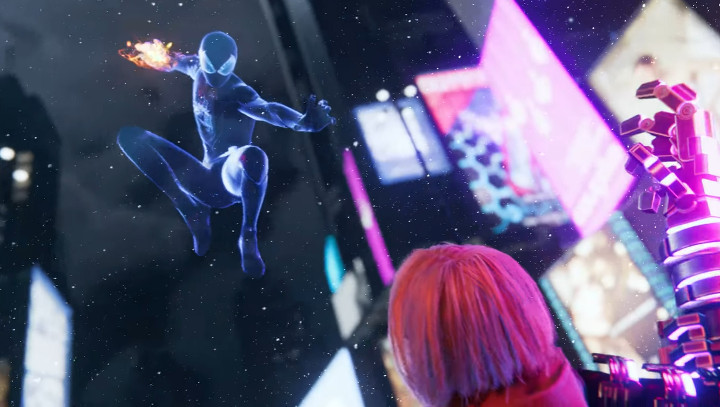
And with the announcement of the upcoming follow up, Spider-Man: Miles Morales slated for release on PlayStation 5 (and possibly PS4) later this year, things are looking up for the Web-Slinger.
cool! i was aware of the vast majority of these, mainly thanks to the inimitable matt mcmuscles – but somehow i didn’t realize until now that the 2000/2001 spider-man and spider-man 2 and the 2002/2004 spider-man and spider-man 2 were two totally different series of titles. hilarious considering vicarious visions handled both enter electro and then later the handheld ports of the tie-in sequel as well. wonder how that announcement went. “alright everyone, we’re doing spider-man 2!” “again?”